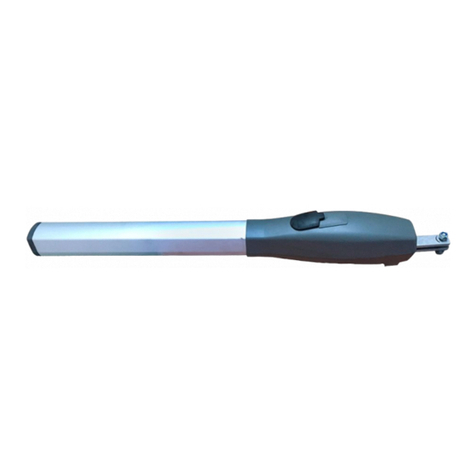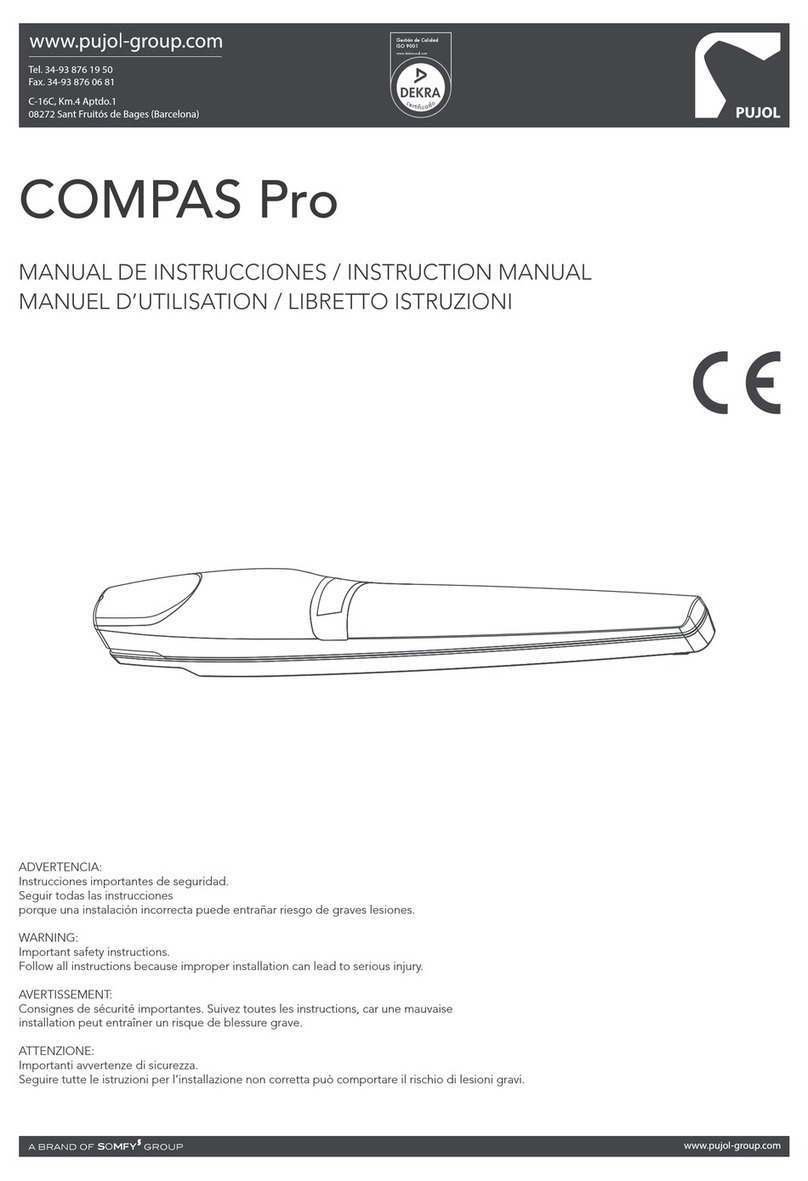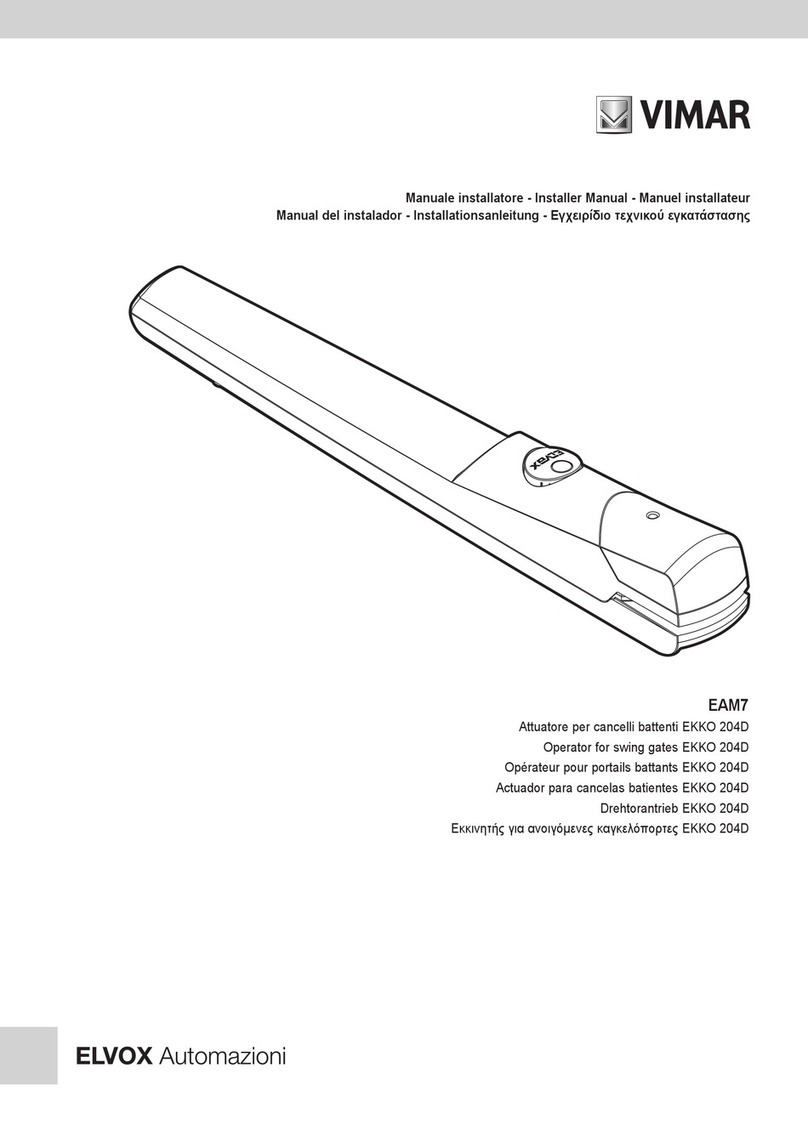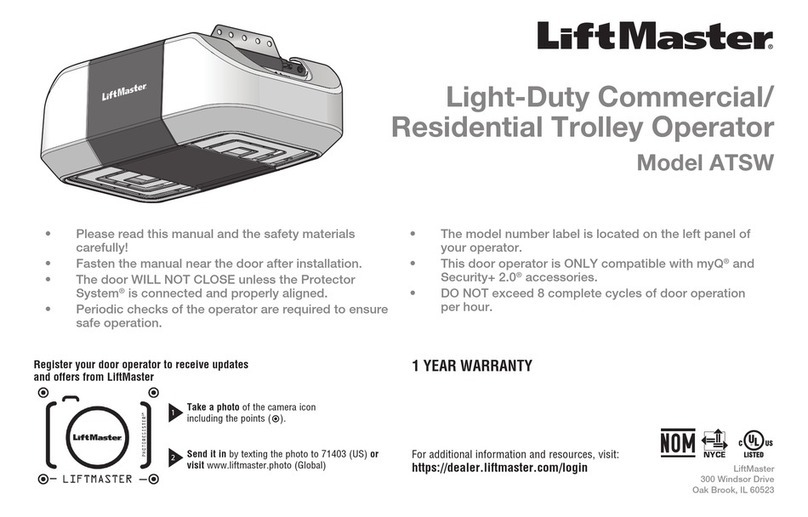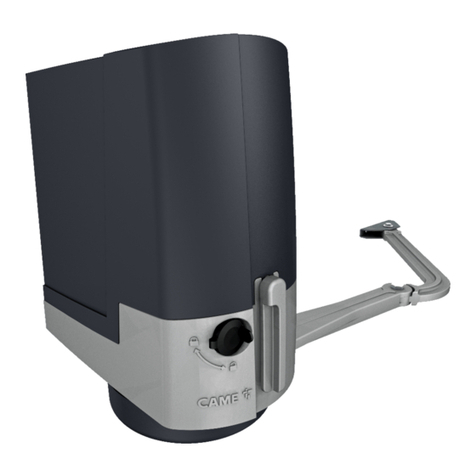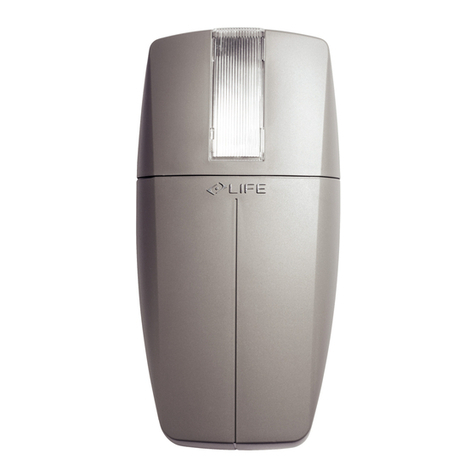Pujol RADIUS E3 User manual

RADIUS
Monuole d'lstruzione
Monuel d'lnslruclions
Instruction mqnuol
Bedienungsonleitung
Monuol de lnstrucciones
MADE IN ITALY
a,)a
XC( @

CARATTERISTICHE TECNICHE . CAFACTERISTIQUES TECHNIQUES - TECHNICAL FEATURES . TECHNISCHE DATEN - cAMcTERiSTICAS TEcNIcAs
Radius E3 tadius E4 Radius E5 Radius E6 Radius E3 Radius E4 I Radius E5 Radius E3 Radius E4
,)11 24V dc
Iotor 280 W300 w
:rolezrone lertrrca - Troleclon Inermtque - I nermtc prolecnon
I'hermoschuE - Protecci6n t6rmic, 150' 150"
3000 N
44
Temperatura di Iunzionamento - Temperature de seruice - Working temperature
Temperaturbereich - Temoeratura de seruicio -20" - +55"C -20" - +55'C
Lunghezza max anta - Vantail maximum - Leaf's maximum length
Max. Fliioelqellanqe - Lonqitud m6x. hoia 2,00 m2,75 m3,50 m4,00 m 2,00 m 2,50 m3,00 n) 2,00 m2,75 n
s,naxttrlurn ou vanra[ - Lear_s maxtmum wetgnl
lvlax. Fliioeloewicht - Peso m5x. hoia 350 Kg 3s0 Kg 250 Kg 250 Kg 275K9 250 Kg 150 Kg 300 Kg 250 Kg
^r 'geru ilra^ ur dper rura_- Ailgrc rndx u ouvenure - Maxrmum opentng
Max. Offnunoswinkel - Anoulo mex. de abertura 110" 110' I 10'
r€mpo or apenura yu - temps o ouvenure 9u'- 9u- opentng
Offnunqszeit - Velocidad anqular 90' 17" 22" 27" 15" 20" 14" 18',
:ka
i{ 20
I
tr
DIMENSIONI - DIMENSIONS. DIMENSIONS. MABANGABEN . DIMENSIONES
L{
coMpostztoNE - coMpostiloN - coMpostfloN - KoMposliloN - coMposlclo
L2
-T
NI
-1
1
2
3
4
no1 Attuatore-Actionneur-Actuator - Triebwerk -Dispositivo
n'1 BR_A Staffa - Patte - Bracket - Bilgel - Abrazadera
n'1 BR_C Staffa - Patte - Bracket - Biigel - Abrazadera
n'1 Kitfissaggio- Kitdefixation - Fixing kit- Kit Befestigung
Kit fieaciones
N"1 lt4anuale d'Installazione e Uso
Manuel d'Installation et Utilisation
Installation and Use Manua
Handbuch der Installation und des Gebrauchs
Manual de Uso e Instalaci6n.
n"1 Manuale Generalite - Manuel Generalites
General Instructions manual - Handbuch Allgemeines
Manual Generalidad
Fotocellule
Photocells
Photocellules
Fotozelle
Fotocdlulas
q wT
(9a
SCHEMA FUNZIONALE . OPERATIONAL DIAGRAM . SCHEMA DE FONCTIONNEMENT
FUNKTIONSPLAN . ESQUEMA FUNCIONAL
Lampeggiatore
Blinker
Clignotant
Blinkleuchte
Luz intermitente
Selettore
Key switch
Contacteur a cl6
Schl0sseltaster
Selector a llave
Centrale
Control unit
Centrale 6lectronique
Steuerung
Central electr6nica
ililil
ililil
!!!ffi|!!ffi
230V

CONDIZIONI OTTIMALI DI INSTALLAZIONE
SUITABLE CONDITIONS OF INSTALLATION . CONDITIONS POUR UNE CORRECTE INSTALLATION
OPTIMALE BEDINGUNGEN VON INSTALLATION . CONDICIONES IDEALES PARA LA INSTALACION
(angolo di apertura 90o/90"opening),
Radius E 300 A=150 B=150
Radius E 400 A=200 8=200
Radius E 500 A=250 8=250
Radius E 600 A=300 8=300
RADIUS E 600 D
A
B
quota staffa
Lungh anta MIN
BR_A
mrnrmo
150 mm
RADIUS E 5 D
A
B
quota staffa
Lungh anta MIN
RAplg5 = OD
A
B
quota staffa
Lungh anta MIN
RADIUS E 3D
A
B
quota staffa
Lungh anta MIN
NB. Nei casi identi?cati dal presente simbolo N 6 necessario integrare
con una staffa aggiuntiva (non in dotazione) che permetta di raggiungere la quota D necessaria,
Radius E 300 = max 125 mm
E 500
E 600
g,--------l-r--
:l
:l
:l A
275 250 225 200 L75 150 t25 100 75 50
273 258 225 288 3L3 300 300 300 300 300
327 302 293 3L2 287 300 300 300 300 300
52
,,8" 52 82 LL2 LL2 150 175
,,Y",,V,,,\J,",,Vi",,ru.J*,,ruj'" 200
"v' 225 250
',V"',V
1300 L280 L280 1280 1260 1270 L270 L27A 127A L270
52 52 82
,,E'r,E' r,V
r.r_50 r_130 1_130
Lt2 LL2 1"50
,,\J'" ,,\J'",,N]"
1130 1l_30 1130
175 2AA 225
'sJ* "ru-l'"s-}"
1-130 1130 1130
175 150 L25 100 75 qn ZA C
L73 198 r.93 188 213 200 200 2AC
227 202 207 2L2 L87 2AA 200 2AC
52 s2 82 LL2 LL2 150 175 20C
,8",,Y",,V.,,,VJ,",,\]",,S].,,ru1",,Q
r.000 980 960 990 970 980 980 S8C
L25 100 7s 50 25 C
L23 1_88 L43 138 163 15C
L77 2L2 L57 162 137 1-5C
52 52 82 1,L2 I12 1-5C
,,Y",ry",,V.,,VJ,,,VJ,,,s
860 840 840 850 820 84C
= max 125 mm

CONDIZIONI OTTIMALI DI INSTALLAZIONE
SUITABLE CONDITIONS OF INSTALLATION - CONDITIONS POUR UNE CORRECTE INSTALLATION
OPTIMALE BEDINGUNGEN VON INSTALLATION . CONDICIONES IDEALES PARA LA INSTALACION
FHI
Fig.3 A
BR_B
BR_A

CRITERI DI SICUREZZA
1 Prima di iniziare qualsiasi operazione di installazione e assolutamente necessario
Ieggere tutto il presente manuale.
2 Verificare che le prestazioni dellhttuatore acquistato corrisponda alle vostre
esigenze di installazione.
3 Inoltre verificare che:
- Le cerniere del cancello siano in buono stato e perfettamente ingrassate,
- Il cancello sia dotato di fermi meccanici in apertura ed in chiusura.
CONSIGLI PER L'INSTALLAZIONE
Collegamenti:
. Vedere "Schema Funzionale" e fare riferimento agli schemi dalla cenkale di
comando.
. Il cavo elettrico in uscita dall'attuatore non deve essere teso, ma fare un'ampia
curva verso il basso onde evitare il riflusso di acqua all'interno dell'attuatore stesso.
(Fis.12)
. Tutti i collegamenti devono essere effettuati in assenza di alimentazione.
. Prevedere un dispositivo di sezionamento onnipolare nelle vicinanze
dell'apparecchio. (i contatti devono essere di almeno 3 mm)
Proteggere sempre l'alimentazione per mezzo di un interruttore automatico da 6A,
oppure per mezzo di un interruttore monofase da 16A completo di fusibili
. Le linee di alimentazione ai motori, alla centrale e le linee di collegamento agli
accessori devono essere separate onde evitare disturbi che potrebbero generare
mal funzionamenti dell'impianto.
. Qualsiasi apparecchiatura (di comando o sicurezza) eventualmente asservita alla
centrale deve essere libera da tensione (contatti puliti).
Partidi ricambio:
. Utilizzare solamente parti di ricambio originali.
. Non eliminare le batterie con i rifiuti urbani ma smaltirle come rifiuti industriali
(Legge n.475l88).
Modalita di installazione:
. Per un uso proprio del prodotto e per escludere ogni possibilita di danneggiamenti a
persone, animali o cose, fare riferimento al foglio "Generalite" allegato che fa
parte integrante del presente manuale.
. L impiego di questa apparecchiatura deve rispettare le norme di sicurezza vigenti
nel paese di installazione oltre alle norme di buona installazione.
Garanzia:
. La garanzia fornita dal costruttore decade in caso di manomissione, incuria, uso
improprio, fulmini, sovratensioni o utilizzo da parte di personale non
professionalmente qualificato.
. Fa inoltre decadere qualsiasi diritto alla garanzia: Non rispettare le istruzioni
riportate sui manuali allegati ai prodotti o I'applicazione anche di un solo particolare
in modo non rispondente alla legislazione vigente o I'utilizzo di parti di ricambio non
congeniali e/o non espressamente approvato dalla ditta costruttrice.
. Il costruttore non pud considerarsi responsabile per eventuali danni causati da usi
impropri ed irragionevoli.
SEQUENZA DI INSTALLAZIONE
1 Prima di iniziare la messa in opera, effettuare sull'installazione l'analisi dei rischi
facendo riferimento al foglio "GeneralitA" che fa parte integrante del presente
manuale, riempire le tabella tecnica e eliminare i rischi rilevati.
Nel caso in cui vi siano rischi residui, prevedere l'installazione con sistemi di
sicurezza completamento,
2 Verificare le norme di sicurezza citate nei"CRITERI DI SICUREZZA"
3 Identificare l'attuatore destro e l'attuatore sinistro.
4 Verificare tutti i componenti.
5 Identificare il punto di ancoraggio sul cancello e di conseguenza sul pilastrino.
6 Verificare la misura "D"
7 AdattarelastaffaBR_AoBR_B "Tabella1"
8 Ancorare il pistone alla staffa BR_A o BR_B.
9 Sbloccare il l'attuatore.
10 Ancorare la staffa BR_C sul cancello.
11 Ancorare la manina del pistone alla staffa BR_C.
12 Stendere i cavi come da "Schema Funzionale"
13 Collegare centrale e tutti gli accessori
14 Programmare il ricevitore radio,
15 Eseguire la programmazione dei"TEMPI DI FUNZIONAMENTO"
In caso di mal funzionamento, fare riferimento alla tabella 'ANOMALIE E
CONSIGLI".
Nel caso in cui non riusciate a trovare alcuna soluzione telefonare al pii vicino
centro di assistenza.
ATTUATORE BLOCCATO
Gli attuatori sono forniti in versione bloccata.
L'elettroserratura deve essere installata sull'anta che si apre per prima e deve essere
collegata ai relativi morsetti della centrale. Posizione dell'elettroserratura: (Fig. 4)
Posizione 1: Scrocco di chiusura nella battuta
Posizione 2: Scrocco di chiusura a pavimento
(in questa posizione l'utilizzo del paletto non d indispensabile).
Ricordarsi di eliminare la serratura o quanto meno renderla inattiva bloccando lo scrocco
in posizione aperta ed eliminare tutti i paletti di chiusura.
ATTUATORE DESTRO O SINISTRO (Fig. 5)
Gli attuatori sono forniti in versione destra e sinistra.
Per stabilire se si necessita di un attuatore Destro o Sinistro guardare il cancello dal
lato in cui e installato l'attuatore, se le cerniere sono sulla destra l'attuatore d destro, se
sono sulla sinistra l'attuatore d sinistro.
DETERMINAZIONE QUOTE DI FISSAGGIO
CANCELLO FISSATO AL CENTRO DEL PILASTRINO (Fig, 2)
In questo caso l'angolo massimo di apedura del cancello d di 90o,
- Il funzionamento ottimale si ottiene piazzando le staffe alle misure indicate.
Nell'ipotesi che cid sia di difficile attuazione procedere come segue;
- Misurare la quota D (distanza tra l'asse delle cerniere e lo spigolo del pilastrino).
- Consultare la tabella 1 e seguire la riga corrispondente al modello di attuatore
acquistato fino ad incrociare la colonna relativa alla quota D.
- Nel riquadro individuato potrete trovare le indicazioni necessarie a stabilire il miglior
utilizzo della staffa BR-A, o in alternativa della staffa BR-B in opzione. (Fig. 7)
Queste quote sono calcolate per ottenere una velociti tangenziale media che non superi
i 12 mt/min.
CANCELLO FISSATO SULLO SPIGOLO DEL PILASTRINO (Fig. 3)
In questo caso il cancello pud aprire con un angolo maggiore di 90o (max 120").
- Il funzionamento ottimale per un/apertura a 90o si ottiene piazzando le staffe alle
misure indicate nel riquadro che sovrasta le fig. 2,
- Per ottenere che l'anta apra con un angolo superiore d necessario fare in modo che
la misura A sia superiore della misura B.
La soluzione ottimale si ottiene aumentando la misura A della stessa dimensione di cui
sidovrir diminuire la misura B.
ALTezzA DI FISSAGGIO (Fig. 6)
Determinare l'altezza di fissaggio dell'attuatore in funzione dalla forma del cancello e
dalle possibiliti di fissaggio su di esso.
a) Se la struttura del cancello d robusta si pud posizionare a qualsiasi altezza senza
limitazioni.
b) Se la struttura d leggera occorre tenere l'attuatore piiJ vicino possibile alla mezzeria
del cancello (in altezza).
Posizione 1 Traversa centrale del cancello
Posizione 2 Rinforzo del cancello
Tenere presente che tra la base della calotta dell'attuatore ed il terreno devono rimanere
almeno 10+15 cm.
FISSAGGIO STAFFE
Tassellare o saldare sul pilastro a lato del cancello la staffa BR-A o BR-B, ricordando
che le m isure A e B sono riferite all'asse delle cerniere del cancello e all'asse di rotazione
dell'attuatore.
Nel caso di fissaggio a mezzo tasselli ad espansione utilizzare tasselli metallici 013 mm e
tenere presente che il tassello deve essere posizionato a non meno di 30+35mm dallo
spigolo del pilastrino per evitare la possibile rottura dello spigolo.
Nel caso di pilastrini in muratura utilizzare tasselli chimici o in resina oppure una staFfa
opportunamente murata.
- Fare attenzione all'utilizzo della staffa BR-A (Fig. 7), la quale dispone di due
versioni, staffa BR-A destra e staffa BR-A sinistra, da utilizzare con il proprio
attuatore: destro o sinistro.
- Fissare l'attuatore alla staffa BR-A come indicato in "Fig. 8" ricordando che il foro
filettato del perno di rotazione PR-A deve essere rivolto verso il basso.
STAFFE BR-B (Fis. 7)
In alcuni casi indicati nella tabella 1 e per particolari applicazioni d consigliabile usare le
staffe BR_B,
Cadauna staffa d composta da no 1 piastra quadrata con dimensioni cm 130x130x6,
completa di 4 fori daA72, edan" 1 staffa 112x94x55 mm con 3 fori da O12.
Modaliti di piazzamento
- Tassfllare la piastra quadrata al pilastrino con robusti tasselli.
- Saldare la staffa alla piastra come indicato nella fig. 7
Ricordare che le misure A e B sono riferite all'asse delle cerniere del cancello e all'asse di
rotazione.
FISSAGGIO DELLA STAFFA ANTERIORE
Determinare la posizione della staffa BR_Cnel modo seguente:
- Chiudere l'anta del cancello.
- Sbloccare il motore.
- Far fuoriuscire completamente lo stelo inox fino al raggiungimento di battuta (max
corsa),
- Far rientrare lo stelo inox di circa 2 cm.
- Posizionare la staffa BR_C nella manina con perno PR-A e relativo grano di
tenuta"Fig. L"(N.8.: parte inferiore)
- Appoggiare la staffa BR-C sull'anta mantenendo l'attuatore in posizione
orizzontale usando una livella, fissare con vite o saldare.
N.B.: Prima di saldare definitivamente le staffe provare ad aprire manualmente
lhnta verificando che riesca ad eseguire manovra completa soddisfacente.
FERMI MECCANICI (Fig. 5)
A questo punto occorre posizionare i fermi meccanici per effettuare il fermo in apertura
dell'anta.
CANCELLO CHE APRE ALL'ESTERNO
Nel caso il cancello apra verso l'esterno d possibile posizionare l'attuatore all'interno.
In questo caso la quota A (distanza tra asse delle cerniere'e asse di rotazione
dell'attuatore) deve essere misurata verso il centro del cancello (Fig. 10) ed occorre
modificare la staffa BR-B per renderla adatta alla nuova posizione di fissaggio.
Per evitare di ridurre la larghezza del passaggio l'attuatore pud essere posizionato nella
parte alta del cancello ad unhltezza non inferiore ai 2 mt.
La posizione della staffa anteriore si trova con il metodo sopra specificato, ma con l'anta
del cancello aperta,
Data la potenza sviluppata dal motore tutti i fissaggi devono essere robusti.
SBLOCCO DELL'ATTUATORE
- Inserire e ruotare di 9Oo anche a pit riprese verso il centro del cancello l?pposita
chiave fornita in dotazione. (Fig.1 1)
- A questo punto d possibile aprire e chiudere manualmente il cancello.
- Per riagganciare l'attuatore ruotare in senso inverso la chiave in dotazione.
Non d necessario che il cancello sia in una posizione specifica in quanto al prossimo
comando si ripristineranno tutti i valori.

SAFETY CRITERIA
1 Attention: before beginning anykind of procedure of installation is absolutely
necessary to read all this manuall.
2 Test/Control that the perfornces of the actuator auswer to your installation needs.
3 Besidescontrol that:
. The gare hinges are in good conditions and perfectly fattened.
. The gate has mechanicall stops in the opening and the closing.
INSTALLATION ADVICE
Connectionsl
. See the "Scheme Functional " and refer to the control central scheme.
. The electric cable in the exit from the actuator must be tight, but do an ample curve
towards the botton in order to avoid the reflux in the inside of the actuator itself.
(Fis.12)
. The adjustment must be effected when the device has no power supply.
. Foresee a omnipolar breaking device near to the apparatus (the contact must
measure at least 3 mm) Always protect the power supply using a 6A automatic
switch, or a 16A single-phase switch fises.
. The power supply lines the motors, to the control unit and the connection lines to
the outfits must be sepated to avoid troubles which could generate problems in the
installation working.
. Any outfits (of control or safety) eventually connected to the control unit must be
tension free.
Spare pafts:
. use esclusively original spare parts.
Installation:
. In order to correctly use the product and to exclude the possibility of injury or
damage, refer to the "Generals" page enclosure, which is an integrated part of this
manual.
. The use of this equipment must be in observance of the safety standards in force in
the country where it is installed, as well as the standards governing proper
installation.
Warranty:
. The warranty supplied by the manufacturer becomes void in the event of
interference, carelessness, improper use, lightening damage, power surges or use
by unqualifi ed personnel.
. The warranty will also become void in the event of the following: Failure to observe
the instructions given in the manuals supplied with the product.
The application of any part in a manner differing from that provided for current
legislation or the use of spare parts which are unsuitable and/or not approved by
manifacturer.
. The manufacturer cannot be held responsible for damages due to improper or
unreasonable use.
INSTALLATION INSTRUCTION SEQUENCE
1 Before the installation, anomalyse the risks referring to the chapter"Generalities"
of this instructions manual, fill the technic table and eliminate the risks a noticed. In
case of more risks, foresee th installation with security system.
2 est the security laws of the "Security Criteria".
3 Identifo the rigutactuatorand leftactuator.
4 Control all the components,
5 Identify the fixing point on the gate and then on the pillar.
6 Veruffponit"D"
7 Adapt the clampt BR-A o BR-B following "Table1"
8 Anchor the piston to the clamp BR_A o BR_B.
9 Unclamp the actuator
10 Anchorthe clamp BR_C on the gate
11 Anchorthemaninaof the pistontotheclamp BR_C.
12 Strech the wires as in the "Functional Swing "
13 Connect the central and all the accessoires
14 Program the radio receptor
15 Pdrogram working times
In case of badworking, see the "Anomalies and Counsuls"
Ifyou do notfind any slution coll the neatestAssistence centre.
LOCKED ACTUATOR
The actuators may be either locked.
Please notice that the electric lock must be installed on the wing that opens first and
must be connected with the terminal board ofthe control unit.
Position ofthe electric lock: (Fig. 4).
Position 1: Lock between the wings
Position 2l Lock in the floor (in this case the utilisation of the bolt is notessential).
Remenberto remove the lock orat least block the lock in opening position and take away
all the bolts of lock.
RIGHT OR LEFT ACTUATORS (Fig. 5)
The actuators are supplied in Right or Left version.
Right or left are established looking the gate from the side where the actuators are
installed, if the hinges are on the right the actuator is right, if they are on the left the
actuator is left.
DETERMINATION OF FIXING MEASURES
GATE FIXED IN THE MIDDLE OF THE PILLAR (Fig. 2)
Inthiscasethe maximal opening cornerof the gate is90o.
- The correct functioning can be obtained putting the fixing brackets at the measures.
In the case that will be difficult to realise do as follows:
- Measure the level D (distance between the hinges'axis and the pillar's edge)
- Look the table 1 up and follow the correspondent line of the model of your operator
untill you cross the line correspondent level D.
- In the finded table you can see the necessary indications and establish the most
suitable use ofthe bracket BR-A oralternatively braket BR-B (Fig.7),
These quotes are calculated in order to obtain an average tangential speed that does not
exceed of 12 m/minute,
GATE FIXED ON THE EDGE PILLAR (Fig. 3)
In this case the gate can open with a corner superior to 90o (max. 1 20o)
- The correct functioning for a 90o deegrees opening is obtained putting the backets
to the measures indicated in the table above picture A and B.
- To obtain that the wing will open with a bigger corner is necessary that measure A
will be superior to measure B.
The best solution can be obtained increasing measure A of the same dimension of wich
must be diminished the measure B.
HEIGHT INSTALLATION
Calculate the height of the actuator installation according to the gate's shape and the
fastening possibiliW. (Fig. 6)
a) Ifthe gate has a big structure you can position it at any highness with no limits.
b) If the structure is light is necessary to put the operator as muca as near as possible
to the cenhe of the gate (in heigt).
Position 1 Central beamofthe gate
Position 2 Stiffen of the gate
Keep attention from the base of the actuator collar and the floor haie to remain more
than 10 +15cm. BRAKET FIXING
Bolt or weld the bracket BR-A or BR-B on the gate's side pillar, keeping in mind that
the measures A and B refer to the gate hinges axis and to the actuator's rotation axis.
In case of fastening by expansion bolts, use 0 1 3 mm metal bolts and place the bolt at no
less than 30+35mm from the pillar's corner, to avoid any corner breaking.
In case of masonry pillars, use chemical or resin bolts or a perfectly stoned bracket,
- Be careful to the utilisation of the bracket BR-A (Fig. 7) which disposes of two
versions bracket BR-A right end bracket BR-A left, that should be used with its
actuator; leftor right,
- Fasten the actuator to bracket BR-A as indicated in "Fig. S" remenbering that the
threaded hole ofthe rotating pivot PR-A must be turned down.
BRACKETS 52 (Fig. 7)
In some ways as indicated in table 1 and for particular installation is suitable to use
bracket BR-8. Each bracket is composed of 1 a squared plate with dimensions 130x130x6
mm, wiyh 4 holes of O12 mm and no1 1 12x94x55 mm v\,Ith 3 holes of 0 12 mm.
Instructions for sutting up
- Screwthe platetothe pillarwuth strong dowels
- To weld the bracket to the plate as indicated in Fig. 7
Remember that the measures A and B are refferred to the hinges axis of the gate and
the rotation axis.
FRONT BRACKET'S FIXING
Determine the position of bracket BR-C as follows:
- Close the gate'swing.
- Rotate counterclockwise the actuator's manina until the end-of-stroke position of
the rod (the rod is completely out), then rotate the manina clockwise until the
manina fixing screw isdown-sided.
In any case the manina must be rotated of half a turn at least.
- Fasten bmcket BR-C to the manina of the actuator as indicated in "Fig. 9"
remenbering that the threaded hole of the rotation pivot PR-A must be turned down.
- Position the actuator on the gate's wing keeping it levelled and mark the position of
bracket BR_C on the gate.
- Weld-or bolt bracket BR-Cto the gate.
MECHANICAL STOP (Fig. 5)
At this point you need to position the mechanical stop to proceed, respectively, to the
wing's closing and opening stop.
EXTERNAL OPENING GATE
In case of external opening gate is possible to place the actuator towards the internal
side.
In this case the quote A (distance between the axe of the hinges and the rotation axe of
the actuator) has to be mesured towards the center of the gate (Fig. 10).
And is necessary to modify the bracket52 to adapt itto the new fixing position.
In order not to reduce the lenght of the passage the actuator can be positioned in the
superior part of the gate at a hightness uninferior of 2 mt.
The position ofthe front bracket will be founded with the method indicated upon, but
with the open wing ofthe gate.
Due to the motor's power, all the fastenings must be strong.
RELEASE OF THE ACTUATOR
- Insert the key (supplied in the kit) and rotate it of 9Oo many times towards the
center of the gate (Fig. 1 1).
- At this point the gate may be opened or closed manually.
- Do the inverse operation to clasp the actuator.
To link the actuator up turn in opposite direction the provided key.
It is not necessary that the gate is not in a specific position because to a next start will be
restored all the previous value

CRITIRE DE SECURITE
1 Avant de commencer quelconque operation d'installation est absolutament
indispensable de lire tout cet manuel.
2 V6rifier l'actionneur en fonction de la largeur du vantail.
3 V6rifier que:
- Les charnidres du portail soient en bon 6tat.
- Le portail doit avoir de butes mdcaniques
CONSIGNE POUR L'INSTALLATION
Raccordements:
. Regarder le "Sch6ma de Functionnement" et le sch6ma dela centrale
6l6ctronique.
. Le cable electrique en sortie du moteur ne doit pas 6tre tendu, mais faire une courbe
vers le bas pour empecher que l'eau suinte a l'interieur du moteur. (Fig. 12)
. Tous les branchements doivent etre effectu6s en absence d'alimentation 6lechique.
. Prevoir un dispositif de sectionnement omnipolaire dans les voisinages de l'appareil.
(les contacts doivent etre de aumoins 3 mm)
Prot6ger toujours l'alimentation parmi un interructeur automatique de 6A, ou parmi
d'un interructeur monofase de 16A complet de fusibles,
. Les lignes d'alimentation aux moteurs, d la central et les lignes d'enclenchements
aux accessoires doivent 6tre sdpardes pour dviter tous ddrangement qui pourraient
causer des fonctionnements ddfectueux de l'installation.
. N'importe quel appareil (de contr6le ou de s0retd) eventuellement asservit e la
central doit 6tre libre de tension.
Parties de r6charge:
. Utiliser seulement parties de 16charge originelles.
. Ne detruisez pas les battries commes des dechds qui sont habituellement enlev6s
par le ramassage municipale, mais traitez-les comme des dech6z industrielles, ( lois
n.475188).
Modalit6 d'installation :
. Pour une utilisation appropri6e du produit et pour exclure toute possibilit6 de
dommages aux personnes, animaux ou choses, faire r6f6rence a la feuille
"G6n6ralit6s" en annexe qui fait partie int6grante de ce manuel.
. L'emploi de ce dispositif doit respecter les normes de s6curit6 en vigueur dans le
pays d'installation ainsi que les normes de bonne installation.
Garantie:
. La garantie fournie par le constructeur est annulde en cas d'alt6ration, de manque
d'entretien, d'utilisation impropre, de foudre, de surtension ou d'utilisation de la
part de personnel non qualifi6 professionnellement.
. Tout droit e la garantie s'annulera 6galement en cas de :
Non respect des instructions report6es sur les manuels fournis avec les produits.
Uapplication m6me d'une seule pidce suivant une modalit6 non conforme d la
l6gislation en vigueur ou l'utilisation de pidces de rechange non conformes et/ou
non express6ment approuvdes le fabricant.
. Le constructeur ne pourra 6tre tenu responsable des dommages 6ventuels
occasionn6s suite e une utilisation impropre et inappropri6e.
SEQUENCE DTNSTALLATION
I Avant de commencer quelconque operation d'installation est absolutament
indispensable de lire tout cet manuel.
2 Ie..CRETERE DE sEcuRITE,,
3 Identifier les actionneurs droite et gauche.
4 V6rifierlacomposition.
5 D6terminer la position pourla fixation des les pattes
6 V6rifiei la quote "D"
7 Adapter le patte BR_A ou BR_B en corrispondence de la Tableau 1.
8 Posittionnerle actionneursur les pattes BR_Aor BR_B,
9 Deblocagedel'actionneur
10 Fixer le patte BR_C sur le portail.
11 Fixerla patte BR_Cd la maninaanterieurede l'actionneur
12 Posittionneir le fil comme da "Sch6ma de functionnement "
13 Brancher la centrale a toutes les accessoires
14 Programmez les t6l6commandes.
15 Programmez le "Temps de Fonctionnement"
15 Aucasdedysfonctionnemntregarder"Anomaliesetconseils".
Au cas ou ce tableau ne repondrait pas a vos questions et ne resoudrait pas
votre disfonctionnement appler notreservice technique.
ACTIONNEUR BLOQUE
Les actionneurs peuvent etre fournis en version bloqu6,
L'6lectroserrure doit 6tre installde sur le vantail qui s'ouvre en premier et doit 6tre
reli6e d la banette de raccordement de la centrale.
Position de la serrure electrique. (Fig, 4)
Position 1: Serrure dans la battue
Position 2i Serrure au sol (dans ce cas n'est pa indispensable utiliser le verrou).
Il faut se rappeler dtliminer la serrure dbrigine ou au moins en la bloquand en position
ouverte et 6liminer tous les verrous de fermeture.
ACTIONNEUR DROITE OU GAUCHE (Fig, 5)
Les actionneurs sont fournis en version droite ou gauche.
On dtablit que le v6rin est Droit ou Gauche en regardant le portail du c6t6 oit
I'actionneur est installd; si les charnidres sont d droite l'actionneur est drojte, si les
charnidres sont i gauche l'actionneur est gauche.
DETERMINATION DES COTES DE FIXATION
PORTAIL FIXE AU CENTRE DU PILIER (Fig. 2)
Dans ce cas l'angle maximum d'ouverture du portail est de 9Oo.
- Pour obtenir un fonctionnement optimal il faut placer les pattes selon les mesures
indiqu6es.
Dans l'hypothdse ou cela n'est pas possible procddez comme suit:
- Mesures la cote D (distance entre l'axe des charnidres et le bord du pilier).
- Consultez le Tableau 1 et suivez la ligne oi se trouve le moddle du systdme que
vous avez achet6jusqu? trouve la colonne qui correspond e la cote D.
- Dans ce tableau vous avez les indications ndcessaires pour 6tablir le meilleur emploi
de la patte BR_A ou bien de la patte BR_B en option (Fiq. 7).
Ces cotes on 6td calcul6es pour obtenir une vitesse tangentielle moyen qui ne d6passe
pas les 12 m/min.
PORTAIL FIXE AU BORD DU PILIER (Fig, 3)
Dans ce cas le portail peut sbuvrir avec un angle de plus de 9Oo (max 1 20o).
- Pour obtenir un fonctionnement optimal avec une ouverture a g0o il faut placer les
pattes selon les mesures indiqu6es dans l'encad16 sur les fig. A et B.
- Si vous voulez obtenir un angle sup6rieure il est n6cessaire que la mesure A soit
sup6rieure d la mesure B.
Vous aurez la solution optimal en augmentant la mesure A de la m6me dimension que
vous diminurez la mesure B,
HAUTEUR DE FIXATION
D6terminer la hauteur de fixation de moteur en fonction de la forme du portail et des
possibilit6s de fixation sur celle-ci. (Fig. 6)
a) Si la structure du portail est robuste vous pouvez placer le moteur ir n'importe quelle
hauteur.
b) Si la structure du portail est fragile il faut placer le moteur le plus pr6s possible de la
mi-hauteur du portail.
Position 1 Traverse centrale du portail
Position 2 Renfortdu portail
Veuillez bien noter que la cdte entre la base du du moteur et le sol il faut au moins 10+ 15
cm.
FIXATION DES PATTES
Cheviller ou souder sur le poteau d c6t6 du portail la patte BR_A ou BR_B comme
sp6cifi6, sans oublier que les quotes A et B se rdfdrent d l'axe des charnidres du portail
et d I'axe de rotation du moteur.
En cas de fixation avec chevilles utiliser des chevilles de 013mm et ne pas oublier que la
cheville doit 6tre positionn6e ir une distance non inf6rieure i 30+35mm de I'ar6te du
poteau afin d'6viter la rupture possible de l'angle.
Dans le cas de poteau en materiau creux utiliser des chevilles chimiques ou en r6sine.
- Faire attention e l'utilisation de la patte BR_A (Fig. 7) la quelle dispose de deux
versions, patte BR_A droite et patte BR_A gauche, A utiliser avec le correct
actuateurdroit ou bien gauche.
- Fixer le moteur a Ia patte BR-A comme indique en "Fig. 8" en ce rappelant que le
trou filet6 du pivot de rotation PR_A doit etre vers le bas.
PATTE 52 (Fig. 7)
Dans certains cas indiquds dans le Tableau 1 et pour des application particulidres il est
conseill6 d'utiliser la patte BR_B. Toutes le patte sont composdes par 1 plaque carre (
dimensions 130x130x6 mm) de 4 trous 012 mm et d'une patte 112x94x55 mm avec 3
trous 012 mm.
MISE EN PLACE
- Fixer la plaque carre au pilier avec des chevilles de qualite.
- Souder la bride i la plaque comme indiqu6 dans la Fig. 7.
Souvenez-vous que les mesures A et B se rdfdrent d l'axe des charnidres du portail a
l'axe de rotation du moteur
. FIXATION DE LA PATTE ANTERIEURE
D6terminer la position de la patte BR_C de la faeon suivante:
- Fermer Ie portail.
- D6verrouillezlev6rin
- Faites tourner completement le tige inox jusqut rejoindre la butde m6canique
(max. course)
- Faites renter le tube inox a peu pr6s pour 2cm
- Positionnez la patte BR_C dans le v6rin avec la cheville PR_A et son grain de
fixation. (Fig. L) (N.B,section inferieure)
- Appuyez la patte BR_C sur le vantail gardant le v6rin en position horizontale e
l'aide d'une livelle et fixez avec une vis ou soudez-le.
N.B, V6rifiez lbuverture manuelle du vantail avant de fixer d6finitivement les pattes
et controlez que le vantail accomplie une manoevre satisfaisante.
BUTES MECANIQUES (Fig 5)
Il faut alors positionner les butes mdcaniques pour effectuer respectivement l'arr6t en
fermeture et l'arr6t en ouverture du portail.
PORTAIL A OUVERTURE VERS L'INTERIEUR
En cas le portail sbuvre vers l'interieur il est possible de positionner le moteur d
l'interieur. Pour ce cas la quote A (distance entre l'axe des charnier6s et l'axe de rotation
du moteur) doit etre mesure vers le centre du portail (Fig. 10) et il faut modifi6r la patte
BR_B pour l'adapter d la nouvelle position de fixation.
Pour eviter de reduire la largeur du passage l'actionneur peut etre positionne en haut du
portail d une hauteur pas inferieur a 2 mt.
La position de la patte anterieure se trouve avec la methode ci dessous specifi6, mais
avec le vantail du portail ouvert.
Selon la puissance d6velopp6e par le moteur toutes les fixations doivent 6tre robustes,
DEBLOCAGE DU MOTEUR
- Introduire et tourner de 90o m6me d plusieurs reprises vers le milieu du portail la
cldfen dotation. (Fig. 11)
- Il est alors possible d'ouvrir et fermer le portail manuellement
- Pour verrouiller ir nouveau lbp6rateur faire avec la cld une rotayion dans le sens des
aiguilles d'une montre.
Il n'est pas ndcessaire que le portail soit dans une position particulidre parce que lors du
prochain cycle toutes les valeurs serons remises e l'6tat initial.

SICHERHEITSKRITERIEN
1 Bevor anfangen alle montierungen fiihrungen es ist notwending dieses manual
Vorsichtig lesen.
2 Kontrollieren dass den Operator erfullt Ihre Verwendungen
3 Und Kontrollieren Sie auch:
- Die Scharnieren der Glittertor sind in gut Bedigungen und gut eingeschmiert.
- Der Glittertor hat mechanishen Befestigung in Offnung und in Verschluss,
HINWEISE ZUR INSTALLATION
Anschliisse:
. Sehen " Das Schema Fluegeltor Funktionierung" und merken die Schema von
den Steurung,
. Den elektriche kabel von den Triebwerke muss nicht gespannt sei, aber eine grosse
kurve unter machen fuer den Wasser Rueckfluss zu vermeiden hinten den
Triebwerke. (Fig. 12)
. Die Anschliisse wie oben beschrieben vornehmen und alle vorgeschriebenen.
Sicherheitsvorrichtungen installieren, bevor die Zentrale mit Strom versorgt wird.
. Alle Anschlilsse mlissen ohne elektronische Versorgung angebracht werden.
. Ein Sektional und Polar Vorrichtung es ist notwendig in der nahe von der Apparat
(Die Kontakten mussen mindenstens 3mm).
Es wird empfohlen, die Stromleitung immer mit einem Schaltautomat zu 64 zu
schiitzen oder mit einem einphasigen Schalter zu 164, komplett mit Sicherungen.
. Die Speisungslinien den Motoren, der Zentrale und die Verbindungslinien den
Zubehorteilen mUssen getrennbt sein, um Storungen Zu vermeiden, die problemen
in der Arbeitsweise des Anglegens bewirken KOnnen.
. Jeder Einrichtung (Steuerung oder Sicherheitsvorrichtung), die Zu der Zentrale
verbunden ist, muR Spannungsfrei Sein
Ersatzteile:
. nur originale Ersatzteile verwenden.
. Bitte: nicht die Batterien zerstoeren wie normalen Abfaellen, sondern wie
industriellen Abfaellen absondern. (Recht475/88),
Installation!
. Ftir einen richtigen Einsatz des Produktes und um jede lYoglichkeit von Schaden an
Personen, Tieren oder Sachen auszuschlieBen, beachten Sie das beiliegende Blatt
,,Allgemeines", das als wesentlicher Bestandteil des vorliegenden Handbuchs
anzusehen ist.
. Der Einsatz der Ausrustung muss den geltenden Sicherheitsvorschriften des
Landes, in dem sie installiert wird, sowie den Vorschriften einer ordnungsgemaBen
Installation entsprechen.
Garantie:
Die vom Hersteller gewahrte Garantie enffallt im Falle von unerlaubten Eingriffen in
die Anlage, Nachlassigkeit, Ivlissbrauch, Blitzschlegen, Uberspannungen oder bei
Bedienung von unzureichend qualifizierten Personen.
. Auch in folgenden Fallen enffallt jeglicher Garantieanspruch: Nichtbeachtung der
Anleitungen des dem Produkt beiliegenden Handbuchs. Anwendung auch nur eines
einzigen Elementes, das nicht den geltenden gesetzlichen Vorschrjften entspricht
Verwendung von ungeeigneten Ersatzteilen und/oder von solchen, die nicht
ausdrlicklich von der Firma genehmigt wurden.
. Der Hersteller libernimmt keine Verantwortung fur eventuelle Schdden, die auf
einen unsachgemaBen und unvern0nftigen Einsatzzuruckzufuhren sind.
INSTALLATIONSFOLGE
1 Befor der anfang der Schaltanlage, machen der Analyse des Risiko und nehmen
Bezug den Elatt "Allgemeine Beratungen" einfullen Sie Tabelle und absondern
die gefunden Risiko. Wenn gibt die Moeglisckeit Risiko zu sein machen Sie die
Installation mit Sichereitsysteme fertig.
2 Kontrollieren die Sichhereit Vorschriften von "Sichereit An lagen"
3 Identifizieren den rechten und IinKen Operator,
4 Nachsehen alle die Komponenten,
5 Identifizieren die Verankerung Punkt aufder Glittertor und aufdem Pfoster
5 Kontrollieren die messe " D".
7 Anpassen Die Buegel BR_A oder BR_B nach die Tabelle 1
8 Verankern den Operaton aufden Buegel BR_A oder BR_8,
9 Entblocken den Operator
10 Verankern die Buegel BR_C auf derGlittertor
11 Verankerndie Endcverschlussden Operatorzu den Buegel
12 Streckendie Kabelnwieinder"Schema FunktionenFluegelTor"
13 Kontrollierenalledie Zubehoren.
14 Programmieren den Empfaenger
15 Programmieren die"FunktionieungZeit"
Wenn etwa in Funktionierung nicht stimmt es ist notwending die Tabelle
"Ungewoenlichkeiten und Beratungen" sehr gut lesen. WennSie keine Loesung
finden koennen wenden Sie sich zum naheren Assitenz Zentrum
GESPERRTES FLIESSWERK
Triebwerke konnen in gesperrter. Bedenken, daB die Elektroverriegelung aufdem Flt.igel,
der sich zuerst Offnet, installiert werden muR und an das Klemmbrett der Zentrale
angeschlossen sein muR, wie aufTafel dargestellt. Stellung der Elektroverriegelung: (Fig. 4)
Stellung 1: Verrieqelung zwischen den Toren.
Stellung 2: Verriegelung auf dem Boden
Fall sich erinnern die Verriegelung abnehmen oder mindestens es unwirksam machen
unt alle Riegeln abnehmen.
TRIEBWERKE RECHT UND LINKES (Fig 5)
Die Triebwerke sind in rechter und linker Version,
Zu vershen ob ein Recht oder Linkes Triebwerke notwenging ist, schauen den Glitter Von
der Seite des installierten Triebwerke, wenn die Scharnieren sint recht der Triebwerke ist
recht, wenn die sint am linkte seite derTriebwerke ist links,
BESTIMMUNG DES BEFESTIGUNGSMASSES
IN PFEILERMITTE BEFESTIGTES TOR (Fig. 2)
In diesem Fall betragt der maximale Offnungswinkel desTors 9Oo.
- Die optimale Funktion erhalt man, indem die Biigel auf den MaBen positioniert wird,
die tiber den Abb. 2 angegeben sind.
Sollte dies nur schwer machbar sein, ist folgendermaBen vorzugehen;
- Das MaR D messen (Abstand zwischen der Scharnierachsen und der Pfeilerkante).
- In Tabelle 1 nachschlagen und der Zeile des gekauften Stellgliedmodells folgen, bis
man die Spalte von MaB D kreuzt.
- In diesem Kastchen finden Sie die notwendigen Angaben, um die beste
Verwendung von Bugel BR_A zu bestimmen oder als Alternative dazu vom
wahlfreien BUcEL BR_B (Fig. 7)
Diese lvlaBe sind so berechnet/ um eine durchschnittliche Tangensgeschwindigkeit von
nicht mehr als 12 Metern/M inute zu erhalten.
AN DER PFEILERKANTE BEFESTIGTES TOr (Fig. 3)
In diesem Fall liegt der maximale Offnungswinkel des Tores iiber 9Oo (max. 120o).
- Die optimale Funktion fur eine Offnung von 90o erhiilt man, indem man die Biigel
auf den MaBen positioniert, die iiber der Abb. 2 angegeben sind.
- Damit sich der Flugel in einem weiteren Winkel Offnet, muss das MaR A groBer als
das MaR B sein.
Die optimale Losung erhalt man, indem das MaR A um die gleiche Dimension vergroBert
wird, um dre man das MaR B verringert,
BEFESTIGUNGSHOHE (Fig, 6)
Befestigungshdhe des Triebwerks unter Beriicksichtigung der Torform und
Befestigungsmoglichkeiten auf diesem bestimmen.
a) Wenn die Torstruktur robust ist, kann man ohne
Einschrankungen auf beliebiger Hdhe positionieren,
b) Bei einer leichten Struktur muss man das Stellglied so nahe wie moglich an der
lvl ittellinie des Tors (bezogen auf die Hdhe) halten.
Stellung 1 Mittlere Tortraverse
Stellung 2 Torverstarkung
Bitte beachten, dass zwischen der Basis der Stellgliedhaube un dem Boden ein Abstand
von 10+1scm bleiben muss.
BEFESTIGUNG BUGELN
Bugel BR_A oder BR_B an den settlichen Torpfeiler di]beln oder schweiRen, dabei
bedenken, daB sich die MaRe A und B auf die Torschafnierachse beziehen und auf die
Rotationsachse des Triebwerks. Falls halbe ExpansionsdUbel angebracht werden, sollten
13mm O Metalldtibel verwendet werden, wobei beachtet werden muR, daR der Ditbel
nicht weniger als 30+35mm von der Pfeilerkante entfernt ist, um eine mcigliche
Beschadigung der Kante zu vermeiden.
Falls die Pfeiler sich in der Mauer befinden, chemische Diibel oder Dijbel aus Harz
verwendenoder ein entsprechend eingemauerter Bilgel.
- Achtung furdue anwendung b0gel BR_A (Fig. 7) die ist in zwei versionen, biigel
BR_A rechts und bi.igel BR_A Links. Zubenutzen mit ihftantriebe rechts oder
links.
- Triebwerk an Btigel BR_A befestigen wie bezeichnet in "Fig. S" merken dass den
geschnitten Loch ueber den Drehzapfen PR1 muss hinunter gedreht worden sein.
BUGEL s2 (Fis, 7)
In einigen in Tabelle 1 angegebenen Fiillen und bei besonderen Anwendungen sollte
der Bilgel BR_B benutzt werden. Jeder Bttgel besteht aus Nr. 1 viereckiger Platte mit
den Abmessungen 130x130x6 mm, komplett mit 4 Ltjchernzu/, 12 mm, und Nr. 1 Biigel
2u112x94x55 mm mit 3 Lochern zu O12 mm.
Aufttellupg.
Die viereckiqe Platte mit starken DUbeln am Pfeilerverdlibeln.
- Den BUgel so an der Platte verschweiBen, wie in Abb. 7 dargestellt.
- Daran denken, dass sich die MaRe A und B auf die Scharnierachse des Tors und auf
die Drehachse beziehen.
FIXIERUNG VON VORNIGER EUGEL
FolgendermaRen die Stellung des Bligels BR_C bestimmen:
- TorflUgel schlieRen.
- Den Motor l6sen.
- Um das komplette Reutierungsmandver zu vollenden m0ssen Sie das Inox Rohr bis
zum Anschlag drehen (Max Lauhl/eg) .
- Das Edelstahlgehause ungefahr 2 cm einspringen machen.
- Die Befestigungsplatte BR_C drinnen dem Gehijuse einstecken, mit Bolzen PR_A
und Dobel "Fig. L" (N.8. unterTeil)
.- Die Befestigungsplatte BR_C auf die Fliigel anlehnen auf horizontal Stellung,
Eine Libelle ware notzlich. Verbolzen oderverschweiRen.
N.B. Die Torbeweglichkeit handpr0fen vor die Platte zu verschweiBen.
DieTor muR eine zufriedenstellende Manover laufen.
MECHANISCHEN SPERREN (Fig, 5)
An diesem Punkt miiBen die mechanischen Sperren positioniert werden, um den
Stillstand beim Offnen und beim SchlieBen des Fliigels zu garantieren.
DER FLUGELTOR DASS OEFFNET VON AUSSERHALB
Wenn der Fltigeltor oeffnet von ausserhalb ist moeglich den Triebwerk von hinten
stellen.
in diesem Fall die MaBe A (die EntFernung zwischen den scharnieracse unt den
Rotationsachse vom Triebwerke) muss ichtung Zentrum der Flugeltor (Fig. 10)
abmesseu worden sey und ist notwending der Bligel BR_B andern um der neue
Befestigung.
Um den Durchgangsbreite nicht abzukuerzen der Triebwerke kann in der obene tail
einordnet sei zu eine Hohe mindestens 2 mt. Die Stellung der VORNIGER BiiGEL kann
wie ist gefundber mit der lvletode der spezifiert, ober mit den Fluegel geoffnet.
Wegen des leistungsstarken Motors sollten alle Befestigungen sehr robust sein.
FREISETZUNG DES TRIEBWERKS
- Passenden Schlilssel (beiliegend) hineinstecken und um 9Oo gegen Tormitte
drehen. (Fig, 11)
- Jetzt ist es moeglich das Gitter handlich zu oeffnen und zu schliessen.
- Um das Stellglied wieder einzuhaken, muss der mitgelieferte Schliissel gegen den
Uhrzeigersinn gedreht werden.

CRITERIOS DE SEGURIDAD
1 Antes de empezar cualquier operacion de montaje es sumamente necesario leer
todo este manual,
2 Averifiguar que las prestaciones del actuator comprado respondan a vuestras
exigencias de instalaci6n.
3 Ademdsaveriguarque:
- Las branches de la cancelas se encuentre en buen estado y sean perfectamente
engrasadas.
- La cancela haya sido dotado de bloqueos mecdnicos en abiertura y en el cierre.
CONSEJOS PARA LA INSTATACI6N
Conexiones:
. Ver "Esquema funcional de puerta a hoja" y referirse a los esquema de la
central de mando.
. El cable electrico a la salida del motor no debe estar tirante, debe hacer una curva
amplia hacia abajo para evitar el regreso de agua al interno del mismo motor. (Fig. 12)
. Todos las conexiones se deben efectuar sin alimentaci6n el6ctrica.
. Prever un dispositivo de repartimiento omnipolar cerca del apaEto (los contactos
tienenque ser de porlo menos 3mm), Proteja siempre la alimentaci6n con un
interruptor automdtico de 6A, o bien con otro monofdsico de 16A completo de
fusibles. La tierra se debe conectar al borne 18 de la centralita.
. Las lineas de alimentacion a los motors, a la central e las lineas de coligamiento a los
accesorios deben ser separadas por evitar disturbios los cuales poderian causar
problemas de funcionamiento.
. Cualquier apreato (de propulsion y de seguridad) eventualmente coligado a la
central debe ser libre de tension.
Piezasde recambio:
. Utilice solamente piezas de recambio originales.
. No eliminar las baterias como basuras urbanos sino como basuras industriales.
(Ley n. 475188)
Modalidad de instalaci6n:
. Para un uso adecuado del producto y para excluir cualquier posibilidad de dafros a
personas, animales o cosas, ver la hoja anexa "Generalidades" que forma pafte
del presente manual.
. El uso de este equipo debe respetar las normas de seguridad vigentes en el pals que
se instala, ademds de las normas de buena instalaci6n.
Garantia:
. La garantia del fabricante caduca en caso de mal uso, desidia, uso impropio, rayos,
sobrecarga de tensi5n, o utilizaci6n por parte de personal no calificado
profesionalmente,
. Se pierde cualquier derecho de garantla cuando: No se respetan las instrucciones
de los manuales anexos a los productos. La aplicaci6n, aunque sea en un solo
detalle, en modo que no responda a la legislaci6n vigente o la utilizaci6n de
repuestos no adaptados y/o no expresamente aprobados por fabricante.
. El fabricante no puede considerarse responsable por posibles dafios causados de
usos impropios e irracionales.
SECUENCIA DE INTALACION
1 Antes de empezar la instalaci6n afectuar el "Analisy de la riegas" referendose a
Ias "Genaralidades" pertenencen a este manual, rellenar el esquema tecnico y
eliminar los riegas relativas,
En el caso en que permanencan unas riegos, eferctuar la instalaci6n con sistemas
de seguridad de completamento.
2 Averiguar las normas de seguridad de los"Criteriasde seguridad"
3 Identificar el actuator Derecho y el actuator Isquierdo,
4 Averiguartodosloscomponientes.
5 Identificar el punto de fijaci6n de la cancela y despuds sobre el pilar.
6 Averiguar la mesum "D".
7 Adaptar las estafa BR_A, BR_B como en el Tabella 1.
I Fijar el pist6n a la estafa BR_A e BR_B.
9 Desbloquearelactuador
10 Fijarlaestafa BR_C sobre la cancela.
11 Fijar la manima del piston a la estafa BR_C,
12 Tirar los cables como en el "Esquema funcional de puerta a hoja".
13 Colegar la central y todo los accessorios.
14 Programar los tiempos de funcionamiento.
En el caso de funcionamiento malo, referirse al esquema "Anomalies y consejos",
En el caso en gue noencontrais mingunasoluci6n llaman el centro de
asistencia m6s cerca,
DISPOSITIVO BLOQUEADO
Los dispositivos se pueden suministrar en versi6n bloqueada.
Recuerde que la cerradura electrica se debe instalar sobre la hoja que se abre primero
y se debe conectaral terminal de bornes de la central.
Posicion de la cerradura elechica (Fig,4)
Posicion 1: Cerradura entre las hojas
Posicion 2i Cerradura a pavimento
(en este caso el uso del cerrojo no es inmdispensabile)
En todos los demSs casos se aconseja utilizar el dispositivo bloqueado.
En este caso recordarse de eliminar la cerradura o cuanto menos desactivarla
bloqueando la cerradura en posicion abierta y eliminar todos los cerrojos de cierre,
DISPOSITMS DERECHO E IZQUIERDO (Fig 5)
Los dispositivos vienen conse6ados en versi6n derecha e izquierda.
Derecha e izquierda vienen establecidas mirando el porton desde el lado donde se
encuentra instalado el dispositivo, si la bisagra estd en la derecha el dispositivo es
derecho, si la bisagra estd en la izquierda el dispositivo es izquierdo.
DETERMINACI6N CUOTAS FIJACION
CANCELA FIJATO EN EL CIENTRO DE EL PILAR (Fiq. 2)
En este caso el Sngulo miiximo de abertura de el cancelo es de 9Oo.
- El funcionamiento optimal se tiene ponendo las abrazadera a las mesuras
seffaladas.
Enel caso que esta operacion es demas difficil proceder comesigue:
- Ivlesurar la cuota D (distancia entre eleje e las charnelasy la esquina de el pilastro
pequeffo)
- Consultar la table 1 y seguir la linea correspondiente al model de un actuator
comprato fino a cruzar la columna corrispondiente a la cuota D,
- En la table lacalizzada se puede encontrar las indicaciones necessarias a establer el
mejor utilizo de la abrazadera BR_A o bien de la abrazadera BR_B en opcion. (Fig.7)
Estas cotas son calculadas por obtener una velocidad tangential media de 1 2/mt./min.
CANCELA FIJADO SOBRE EL CANTO DE EL PITAR (Fiq. 3)
In este caso la cancelada puende aprir un angulo major de 90o (max. 1 20o).
- El funcionamiento optimal por una abertura a 90o se realiza ponendo las patas alas
mensuras aconsejadas en la tabla Fig. 2.
- Por uer que la oja abre con un angulo superior es necessario que la mesura A es
superior de la mesura B.
La mejor solucion se realiza aumentando la mesura A de Ia misma dimension que se
disminuir la mesura B.
ALTURA DE FIJACION
Determine la altura de fijaci6n deldispositivo en funci6n de la forma de la puerta y de las
posibilidades de fijaci6n sobre si misma. (Fig. 6)
a) Si la estructura de la cancela es robusta se puede posicionar a cuelquier altela sin
limite.
b) Si la estructura es ligera es necessario poner el actuator mas cerca ala midad de la
cancela ( en altura).
Position 1 Travesia central de la cancela
Position 2 Refuerzo de la cancela
Non olvidar que entre la base de la calotta de el actuator y el terreno debono ser al
menos 10 +15 cm.
FTgACTONES DES LAS ABRAZADERAS
Encajar o soldar en el pilar al lado de la puerta la abrazadera BR_A o bien abrazadera
BR_B, recordando que las medidas A y B se refieren al eje de las bisagras de la puerta
y al eje de rotaci6n del dispositivo.
En el caso de fijaci6n por medio de tornillos de expansi6n utilice tacos metSlicos de
A73mmy tenga presente que el taco se debe colocar a no menos de 30+35mm de la
arista del pilar para evitar la posible rotura de la arista. En el caso de pilares en el muro
utilice taquetos quimicos o en resina o bien una abrazaderas sumamente murada.
- Hacer muy atencion al'utilisation de la ambrazadera BR_A (Fig.7) la cual se
compone de dos versiones, ambrazaderas BR_A derecha y ambrazadera BR_A
isquierda, que debo ser utilizada con el suo motor: derecho o bien isquierdo.
- Fijar el motor a la abrazadera BR_A como se indica en la "Fig. S" recordando que el
agujero fileteado del perno de rotacion PR_A debe estar girado hacia abajo.
ABRAZADERAS BR_B (Fig. 7)
In algunos casos en la tabla 1 y por applicaciones particulares es aconsejable usar la
abrazaderas BR_B. Cada abrazaderas es echa par n"1 planche cuadrada con
dimensiones 130x130x6 mm compleda de 4 agujeros da 012 mm y da no1 abrazaderas
112x94x55 mm con 3 agujerosda @ 12 mm.
Modalidad de colocacion
Taracear la abrazadera cuadrata al pilastro pequefro con robustos taruguillos. '
- Soldar la abrazadera plancha como indicado en la Fig.7.
- Recordarse que las mesuras A y B son referidas al eje de las charnelas de Ia
cancela y de el eje rotacion.
FI9ACION DE LA ABRAZADERA ANTERIOR
Determrnar la posici6n de la abrazadera BR_C de la siguiente manera:
- Cerrar la hoja de la cancela.
- Desbloquear el motor
- Hacer girar el v6stago inox completamente hasta alcanzar el seguro meciinico (max
carrem).
- Retirar el tubo de acero de 2 cm aprox.
- Introducir la plancha de fijaci6n abrazadera BR_C dentro el tubo, con su perno
PR_A y grano "Fig. L" (N.8. lado inferior)
- Apoyar Ia plancha de fijaci6n abrazadera BR_C sobre el tubo en posici6n
horizontal usando un nivel de aire. Fixar com um parafuso ou saldar.
' N.B. Averiguar a funcionalidade da porta, Ia puerta abriendola manualmente,
asegurando que la hoja haga una maniobra satisfactoria, antes de saldar las
planchas de fijaci6nes ,
TOPES MECANICOS (Fig. 5)
A este punto es necesario colocar los topes mecdnicos para efectuar respectivamente el
tope de cierre y el tope de apertura de la hoja de la pueda.
CANCEL QUE ABRE HACIA EL ESTERNO
En el caso que el cancel abra hacia el esterno es posible posicionar el motor al interno.
En este caso la medida A (distancia entre el eje de la bisagra y el eje de rotacion del
motoQ debe ser tomada hacia el centro del cancel (Fig. 10) y ocurre modificar la
abrazadera BR_B para adaptarla a la nueva posicion de fijacion,
Para evitar de djsminuir el ancho del pasaje el motor puede ser colocado en la parte alta
del cancel a una altura no inferior a los 2 mts.
La posicion de la abrazadera anterior se encuentra con el metodo indicado arriba, pero
con la hoja del cancel abierta,
Dada la potencia desarrollada por el motor todas las fijaciones deben ser robustas,
DESBLOQUEO DEL DISPOSITIVO
- Introduzca y gire 90o tambien mas veces hacia el centro de la puerta la llave
adecuada (suministrada en dotaci6n). (Fig. 1 1)
- A este punto es posible abrir y cerrar el cancel manualmente.
- Para reenganchar el actuator dar vueltas al reverso la llave en dotacion.
Non es necessario que la cancela sea en una posicion particular porque a el proximo
comando restablecean todos los valores,

0l
02
03
o4
05
06
07
ESPLOSO
SCRETBD50
SCRETBS60
sMoB902
SGHO]
MVl0630A
MDAMO6AB
SBU22
svt30r 30
svt40130
svt50130
MPLROOl
sNz90
MPA24407
Corpo ridutiore dx ELITE new
Corpo riduttore sx ELITE new
Mozzetto bloccoio
Ghiero in zomo filettoio
Vite M6x30 per coll. vite
Dodo M6 outobl. zinc.
Bussolo ocetol
Vile L= 400
Vite L= 500
Vite L= 500
Rondello in plostico
Noltolino di sblocco
Poroolio 40x24x7
Tubo olu L=420 vern.
Tubo olu L=520 vern.
Tubo olu L=620 vern.
Bussolo in bisolfuro
Roschiopolvere
Bussolo PVC nero
Tubo inox L=420
Tubo inox L=520
Tubo inox L=620
Monino verniciolo
Vite M5x20
Rondelle O 5 zinc. elosf.
I8 MTPO2
19 MPCOI
20A SCABOIN2
20 B SCAAOIN2
21 SST4t445
22 SALBAS4590
23 SMT205
24 SCHoI90
25 MTPI2
Toppo colotto bosso
Possocovo
Coloito vernicioio bosso
Coloito vernicioio olto
Stotore 14009. H45
Albero bloccoto finito
Motore 24V
Chiove di sblocco in zomo
Toppo protezione notiolino
08
09
t0
il
12 MBUOS
I3 MRPOI
14 MBU23
t5 sTr30r20
sTt40r 20
sTt50l20
16 SMAoI N 180
17 MV|0520CZ
MROOSEZ
dN@9.6\.
6?
)4V
c
I
-W
g
@
@
@@
@
.,@
This manual suits for next models
3
Table of contents
Languages:
Other Pujol Gate Opener manuals
Popular Gate Opener manuals by other brands

Roger Technology
Roger Technology M30 Series INSTRUCTIONS AND RECOMMENDATIONS FOR THE INSTALLER

Viking
Viking G-5 Installation instructions and safety information
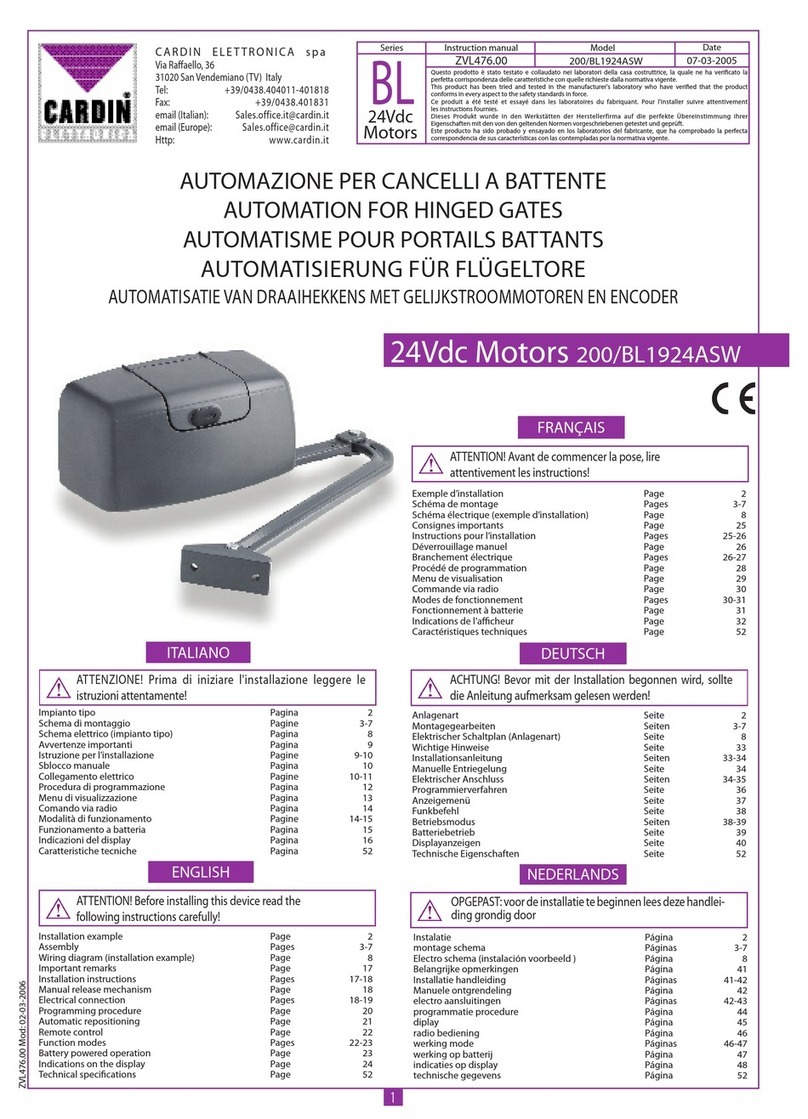
Cardin
Cardin 200/BL1924ASW instruction manual

Calimet
Calimet CM3-DCNB instruction manual
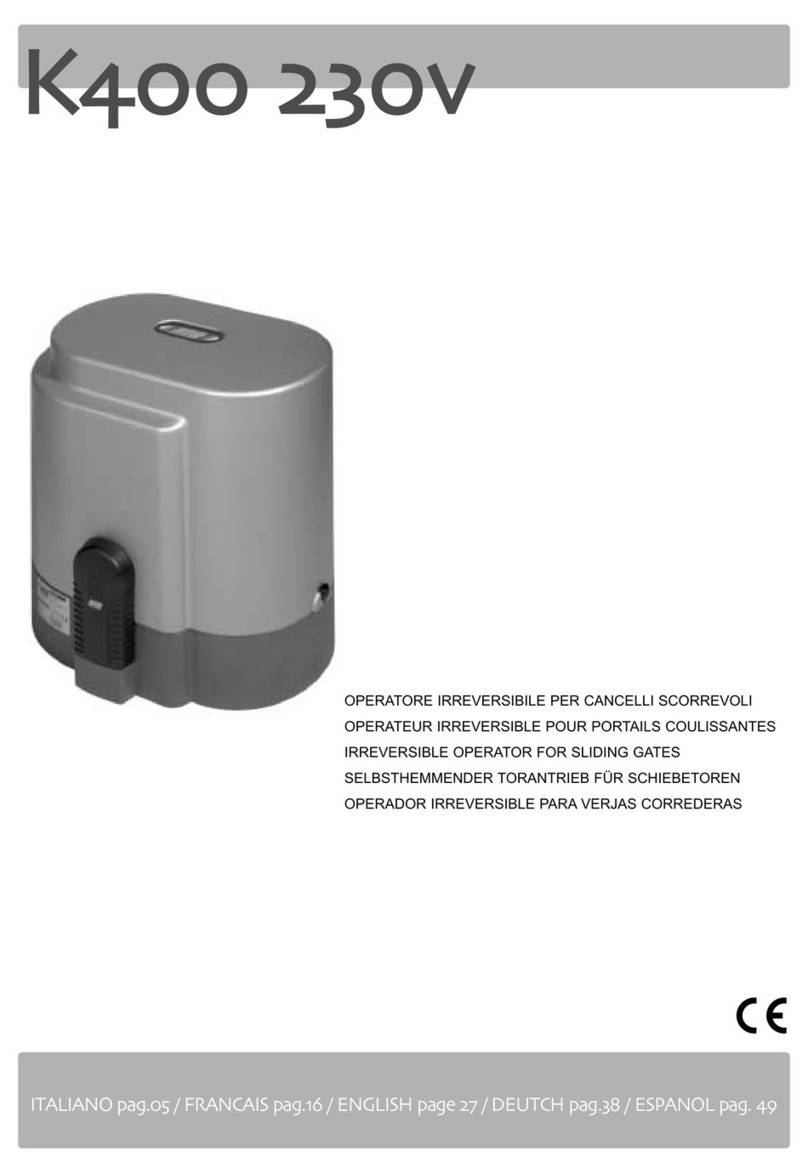
Ribind
Ribind K400 230V instructions
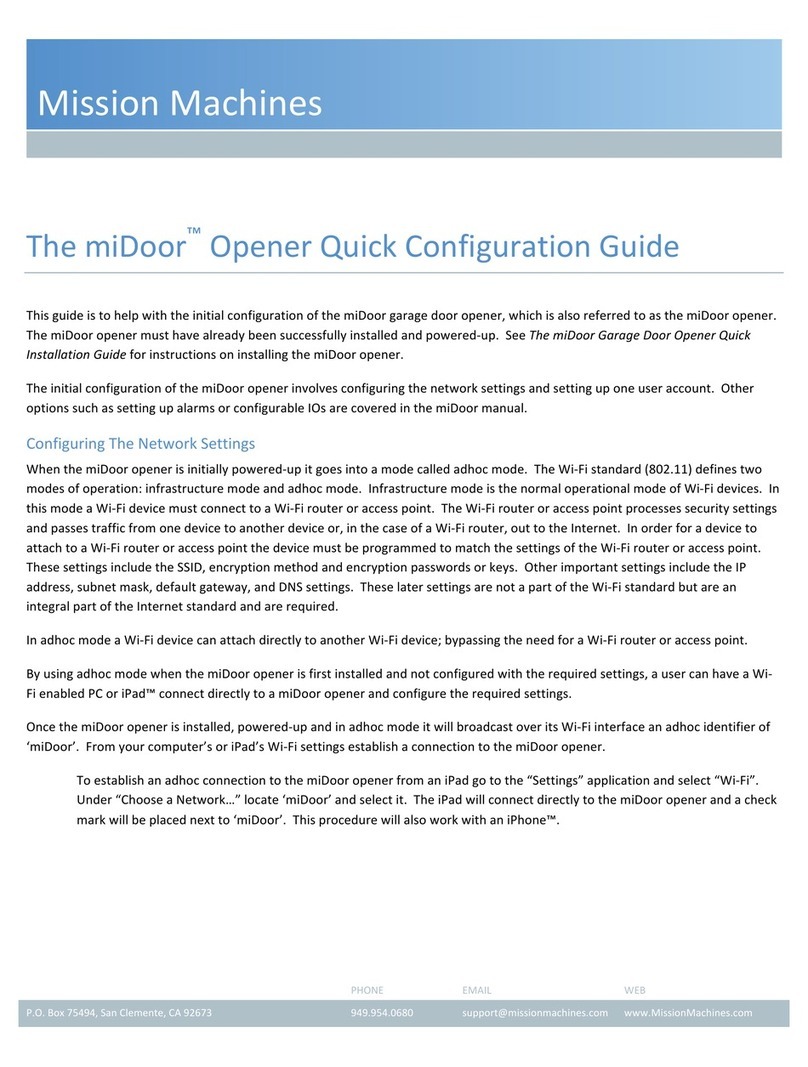
Mission Machines
Mission Machines miDoor Quick configuration guide
